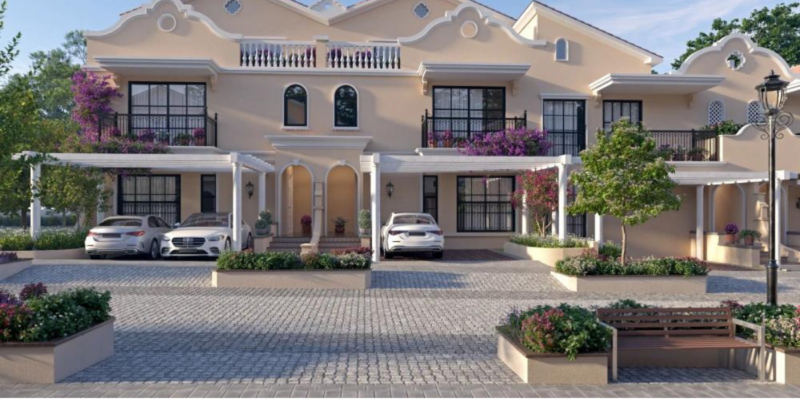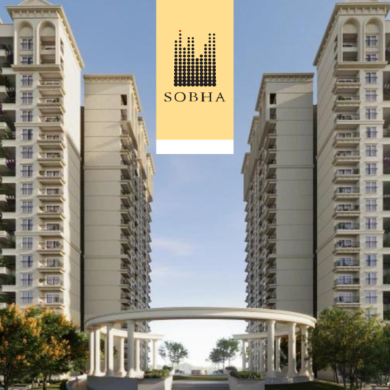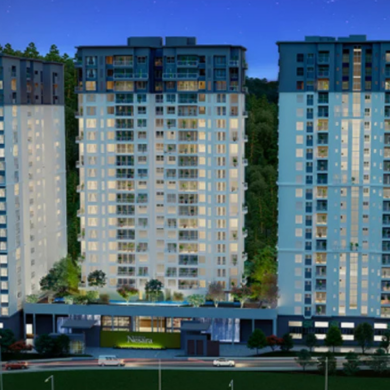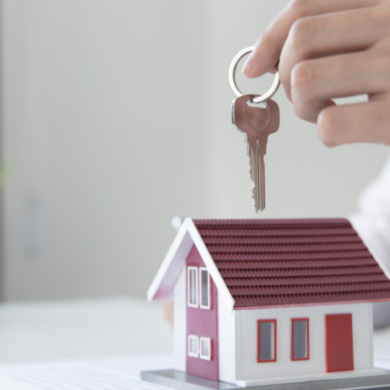
Row houses are multi-story properties that share walls with neighboring units. They offer privacy and a sense of ownership with their own entrance and front yard. Apartments are found in high-rise buildings and have multiple units within one structure. Apartments also provide maintenance services and secure access points for a hassle-free and safe living experience.
A comprehensive overview of various housing options equips individuals with a profound understanding of the diverse choices available to cater to their specific needs. These options encompass independent homes, row houses, apartments, and villas. Independent homes offer abundant space and privacy, albeit demanding more maintenance and incurring higher costs.
Row houses strike a balance between luxury and shared amenities while also providing more living space compared to apartments. On the other hand, apartments present a cost-effective choice for those seeking convenience and minimal upkeep, albeit potentially limited in square footage. Villas offer ownership of the plot and the unit with shared facilities.
Row houses and apartments are two distinct residential units, each with unique characteristics and benefits. Row houses, known as townhouses, are typically multi-story properties that share walls with neighbouring units. They offer a sense of privacy and ownership, as each unit has its own entrance and front yard. Furthermore, row houses often come with additional outdoor space in the form of a backyard or rooftop terrace, providing residents with a private oasis amid urban living.
On the other hand, apartments are more commonly found in high-rise buildings and consist of multiple units within a single structure. They foster a greater sense of community due to shared amenities such as gyms or swimming pools. Additionally, apartments often include benefits like maintenance services and secure access points, ensuring a hassle-free and safe living experience.
-
Table of Contents
Definition and Structure of Row Houses and Apartments
Row Houses
Row houses are architectural structures comprising a series of single-family homes that are typically connected in a row and share common side walls. This design not only optimises the utilisation of urban space but also preserves a strong sense of community and individuality. The layout of row houses usually entails uniform facades, symmetrical proportions, and a consistent roofline, resulting in a visually pleasing streetscape.
While the exterior appearance may appear similar across all units, the interior layouts can vary significantly to cater to the preferences and needs of residents. Row houses often span multiple floors, with living spaces on the lower and bedrooms on the upper levels. This arrangement ensures efficient land use in densely populated areas, minimising footprints without compromising on living space.
Moreover, row houses foster social interaction among neighbours due to their shared walls and proximity, creating a tight-knit community atmosphere. The close bonds within these dwellings promote a sense of neighbourly connectivity, enhancing the overall living experience.
In essence, row houses balance privacy and neighbourly connectivity while exemplifying architectural harmony within urban landscapes. Their ability to maximise urban space, preserve community values, and offer customisable living arrangements make them a desirable housing option in today’s urban environments.
Apartments
An apartment is a self-contained housing unit that is integral to a larger building or complex. It typically comprises one or more rooms specifically designed for living, dining, and sleeping, in addition to a well-equipped kitchen and multiple bathrooms. Apartments come in various sizes, ranging from cosy studio units to luxurious penthouses, offering a wide range of layouts to cater to diverse needs and budgets.
The architectural design of an apartment building often involves multiple floors with individual units stacked on top of one another. Each apartment is usually equipped with a private entrance, ensuring utmost privacy for its occupants. Moreover, apartments may boast of shared amenities such as parking areas, swimming pools, fitness centres, and communal spaces like lobbies or courtyards.
This unique definition and structure make apartments appealing for urban dwellers seeking convenient housing solutions in densely populated areas with limited space, but lifestyle needs take precedence.
-
Architectural Design of Row Houses & Apartments
Row Houses
The architectural design of row houses requires a meticulous approach that harmonises efficiency, aesthetics, and functionality within a limited space. A professional architect maximises the available area through thoughtful layouts and innovative techniques. Each unit is carefully crafted to ensure optimal space utilisation while maintaining privacy and individuality for each dwelling.
The design incorporates critical elements such as prominent entrances and façades that create a cohesive whole, emphasising the unity within the row house community. Attention to detail is given to exterior finishes, rooflines, fenestration patterns, and materials selection to enhance the overall appeal and create harmony between adjacent units.
Interior spaces are intelligently designed to provide ample daylighting, ventilation, and open living areas seamlessly connecting with outdoor rooms or courtyards. Furthermore, architects prioritise sustainability by incorporating energy-efficient systems and environmentally friendly practices into their designs, ensuring a responsible and efficient use of resources throughout the lifespan of these urban dwellings.
This nuanced approach by professional architects results in distinct row house communities that embody both practicality and elegance in contemporary urban architecture. The result is a harmonious blend of functionality and beauty, creating a living environment that is both efficient and visually appealing.
Apartments
The architectural design of apartments plays a pivotal role in creating living spaces that are both functional and aesthetically pleasing. Professionals in this field deeply understand the significance of maximising every inch of the apartment while ensuring a sense of openness. Meticulous attention is given to the layout, guaranteeing efficient space usage and a seamless flow between rooms. The selection of materials also contributes significantly to the overall atmosphere, as designers must strike a delicate balance between durability, practicality, and beauty.
The presence of adequate natural light is of utmost importance, and this is achieved through the strategic placement of windows and open floor plans that seamlessly connect indoor and outdoor spaces. Moreover, professionals in architectural design pay meticulous attention to detail, incorporating elements such as storage solutions, versatile built-in furniture, and innovative use of vertical space where necessary.
In conclusion, the art and science behind designing apartments require a high level of expertise in spatial planning, selecting appropriate materials, manipulating lighting conditions, and focusing on functionality without compromising style. Through the mastery of these skills, professionals in this field can create living spaces that are not only visually appealing but also highly practical and conducive to a comfortable lifestyle.
-
Ownership and Independence in Row Houses vs Apartments
Row Houses
Row houses offer a distinctive combination of ownership and autonomy within urban settings. One noteworthy aspect of owning a row house is the sense of individual ownership, as an individual or family privately owns each unit. This sets row houses apart from apartments or condominiums, where units are often rented or collectively owned.
Moreover, row house owners enjoy the freedom to personalise their living spaces according to their preferences while benefiting from the social connections fostered by close proximity to neighbours.
The shared walls inherent in row houses create a sense of community among residents, who often share common areas like front yards or driveways. This unique feature cultivates a feeling of togetherness, striking a harmonious balance between independent homeownership and the inherent connectedness of residing in a closely-knit urban neighbourhood.
Apartments
Ownership and independence in apartments encompass a multitude of factors that are paramount for potential buyers or tenants to contemplate when searching for a place to call home. Ownership entails complete control and decision-making authority over the property, allowing individuals the freedom to personalise, renovate, or even sell it according to their preferences. Furthermore, owning an apartment ensures long-term stability and the opportunity to amass equity through mortgage repayments.
Conversely, renting an apartment offers flexibility and mobility that resonates with individuals prioritising lifestyle adaptability. While renters may not enjoy the exact extent of freedom as owners, they gain access to communal amenities and are relieved of the maintenance costs typically associated with homeownership.
Ultimately, the decision to own or rent an apartment should be based on personal preferences, financial considerations, plans, and lifestyle requirements, all contributing to achieving the ideal balance between independence and responsibility. By carefully weighing these factors, individuals can make an informed choice that aligns with their unique circumstances and aspirations.
In conclusion, choosing between ownership and renting apartments is a multifaceted decision that necessitates thoughtful deliberation. Whether one seeks the autonomy and customisation that comes with a license or the flexibility and convenience offered by renting, it is crucial to consider the various aspects that influence this decision. By doing so, individuals can find the perfect abode that meets their immediate needs and aligns with their long-term goals.
-
Maintenance and Responsibilities
Row Houses
Regarding row houses, maintenance and responsibilities are paramount in ensuring the longevity and functionality of these interconnected dwellings. As each unit shares common walls, proper upkeep benefits individual homeowners and contributes to harmonious living within the row house community.
Homeowners must understand their maintenance responsibilities, which often include regular inspection of their property’s exterior and interior, promptly addressing any structural repairs or maintenance issues that may arise, and maintaining a tidy and well-manicured frontage. Additionally, residents must adhere to community guidelines regarding noise levels and shared spaces such as parking areas or gardens and cooperate with neighbours concerning the collective benefit of all inhabitants.
By diligently attending to their maintenance obligations and being mindful of their responsibilities towards fellow row house members, homeowners can ensure an ideal living environment where respect for space, proper upkeep of properties, and neighbourly harmony prevail.
Apartments
Maintenance and responsibilities in apartments are crucial factors that contribute to the successful management of residential complexes. As a property owner or manager, it is essential to ensure regular maintenance checks are conducted to address potential issues promptly. This includes thorough inspections of plumbing, electrical systems, heating and cooling appliances, and common areas such as staircases and elevators.
Furthermore, assigning responsibilities to tenants regarding cleanliness and minor repairs within their units fosters a sense of ownership in the community while alleviating the burden on property managers. By implementing clear guidelines for residents on waste disposal and environmental regulations, we encourage sustainable living and create a safe and healthy environment for all occupants.
By diligently upholding these maintenance practices, apartment complexes can thrive as highly desirable living spaces that meet residents’ expectations while preserving the overall value of the property in question.
-
Privacy and Noise Considerations in Row Houses and Apartments
Row Houses
Privacy and noise considerations are of utmost importance in row houses, as they significantly contribute to creating a comfortable living environment for residents. Since row houses typically share walls with neighbouring properties, it becomes imperative to address privacy concerns to maintain a sense of personal space.
Implementing measures such as soundproofing becomes crucial to tackle this issue effectively. This can be achieved by utilising insulation materials and double-glazed windows, which work together to minimise noise transmission between units. Moreover, privacy can be enhanced by strategically placing common areas, such as bedrooms, away from shared walls. Additionally, installing privacy screens or curtains can provide a layer of seclusion.
Furthermore, it is essential to establish thoughtful community guidelines that promote respectful behaviour among neighbours. These guidelines aim to reduce noise disturbances that may arise from the shared walls. By prioritising privacy and taking proactive steps to address noise concerns in row houses, residents can fully enjoy their homes without compromising the tranquillity and peacefulness that are essential elements of the property’s charm.
In conclusion, by recognising the significance of privacy and noise considerations in row houses and implementing effective measures such as soundproofing and strategic placement of common areas, residents can experience a truly comfortable and serene living environment. Additionally, establishing community guidelines that foster respectful behaviour among neighbours further contributes to maintaining a peaceful atmosphere. Ultimately, by prioritising privacy and taking proactive steps, row house residents can fully appreciate their homes’ charm and tranquillity.
Apartments
Privacy and noise considerations are crucial when evaluating the quality of living spaces in apartments. Privacy can become a significant concern in densely populated urban areas, where living spaces are often limited. Tenants require assurance that they will not be subjected to unwanted visual or auditory intrusions from neighbouring units. This can be achieved by implementing adequate insulation, soundproofing materials, and thoughtful layout designs that minimise shared walls between apartments.
Moreover, effective window treatments such as blinds or curtains and well-placed landscaping can create a sense of seclusion and prevent outsiders from peering into private spaces. Equally important is the issue of noise disturbances within apartment complexes. Property developers should prioritise construction methods that minimise the transfer of sound vibrations between units, ensuring a peaceful environment for residents.
By addressing privacy and noise considerations, tenants can enjoy a comfortable and tranquil living experience in their apartment homes. Property developers and landlords need to recognise the significance of these factors and take appropriate measures to meet the expectations of their residents.
-
Cost Considerations
Row Houses
Cost considerations are crucial in the decision-making process when selecting a row house. One of the primary advantages of living in a row house is its affordability, as these properties tend to be more budget-friendly than detached houses or condominiums. However, several factors contribute to the overall cost of owning a row house. These include maintenance expenses, homeowners association fees, and shared utilities.
Since multiple units share common walls and infrastructure, repairs may necessitate coordination among neighbours and can sometimes incur additional costs. Moreover, while homeowner associations ensure well-maintained communal areas, these amenities come at a price that should be considered when budgeting. It is also essential for potential buyers to consider long-term costs such as property taxes and insurance premiums, which may vary depending on location and local regulations.
Prospective buyers should carefully evaluate all these factors before purchasing a row house. By doing so, they can make an informed financial decision that aligns with their needs and budget constraints.
Apartments
When evaluating cost considerations in apartments, several factors come into play. Firstly, it is essential to assess the rental price and determine whether it aligns with the amenities provided and the property’s location. Additionally, potential tenants should inquire about additional fees or charges not included in the monthly rent, such as utilities, parking, or pet fees. This comprehensive approach allows for an accurate calculation of the overall cost.
Moreover, individuals should consider the long-term expenses of renting an apartment, including maintenance costs and potential rent increases. By taking these factors into account, one can gain a better understanding of the financial implications and make an informed decision. It is crucial to analyse the overall value for money by comparing similar properties in the area. This ensures that a fair market rate is offered and prevents potential exploitation.
Lastly, personal financial constraints play a vital role in determining affordability. It is important to consider monthly income, budget for other expenses and debts, and avoid overextending financially. By doing so, one can maintain financial stability and avoid compromising on other essential aspects of life.
By carefully examining all these cost considerations in apartments, prospective tenants can make informed decisions that align with their financial goals and lifestyle needs. This approach allows for a more professional and comprehensive evaluation, ensuring that the chosen apartment meets financial and personal requirements.
-
Resale Value
Row Houses
The resale value of rowhouses in today’s market is subject to fluctuations based on various factors that potential buyers consider. Primarily, the location of a rowhouse plays a pivotal role in determining its worth, as it significantly influences its desirability and accessibility to amenities. Neighbourhoods boasting reputable schools, well-maintained infrastructure, and proximity to transportation hubs tend to command higher prices upon resale.
Furthermore, the condition and age of a rowhouse significantly impact its market value. Buyers generally gravitate towards properties requiring minimal renovations or repairs, resulting in higher resale prices for newer or recently renovated homes. Additionally, a row house’s size and layout can influence its resale value. Properties featuring spacious rooms, ample storage space, and functional floor plans attract more interest from potential buyers.
Ultimately, while it is impossible to guarantee future fluctuations in the real estate market, making wise investments in desirable locations with well-presented rowhouses is likely to yield favourable resale values over time.
Apartments
The resale value of apartments is significant for both potential buyers and investors. Numerous factors play a crucial role in determining the resale value of a flat, including its location, amenities, market conditions, and overall demand.
Apartments in prime locations, boasting excellent infrastructure and easy access to essential facilities, tend to command higher resale values. Proximity to business districts, educational institutions, medical facilities, and transportation networks contribute significantly to an apartment’s perceived value. Moreover, the presence of top-notch amenities like swimming pools, gyms, parking spaces, and security systems can also positively influence its resale value.
Potential investors must diligently monitor market trends to make well-informed decisions regarding apartment purchases that are likely to appreciate over time. By doing so, they can seize lucrative real estate investment opportunities.
It is imperative to consider all these factors collectively to understand an apartment’s resale value comprehensively. Therefore, thoroughly considering these factors is paramount when evaluating real estate investment prospects professionally.
Row Houses Vs Apartments
Feature |
Row Houses |
Apartments |
|
Ownership |
Typically owned individually |
Units are owned individually or rented |
|
Structure |
Connected units in a row |
Multiple units in a single building |
|
Privacy |
More privacy due to separate units |
Less privacy, shared walls and spaces |
|
Space |
Usually more spacious, both indoors and outdoors |
Compact living spaces, limited outdoor areas |
|
Maintenance |
Individual maintenance responsibility |
Typically managed by a homeowners’ association or building management |
|
Amenities |
May have individual or shared amenities within the community |
Centralized amenities like gyms, pools, etc. shared among residents |
|
Customization |
More flexibility for customization |
Limited customization due to shared structure |
|
Costs |
May have higher initial costs |
Generally more affordable upfront costs |
|
Community |
Often has a closer-knit community |
Larger and more diverse resident population |
|
Resale Value |
Resale value may be influenced by individual upkeep |
Resale value can be influenced by the overall condition of the building and amenities |
|
Maintenance Costs |
Individual responsibility for maintenance costs |
Shared maintenance costs through association fees |
Note: It’s important to know that individual row houses and apartments can vary significantly, and the above points represent general trends. Individual preferences, lifestyle, and location can play a significant role in choosing between row houses and apartments.
Conclusion
Row houses and apartments are both highly sought-after options for urban living, yet they possess distinct differences that significantly impact the overall living experience. Row houses are typically multi-level properties that offer a heightened level of privacy and ample space compared to apartments, affording residents the luxury of enjoying multiple levels and private outdoor areas such as backyards or patios.
On the contrary, apartments are:
- Purpose-built units nestled within larger buildings.
- Often boasting an array of amenities such as state-of-the-art gyms.
- Refreshing pools.
- Round-the-clock security.
While row houses foster a sense of community due to shared walls and proximity to neighbours, apartments provide greater convenience through on-site maintenance services.
Moreover, row houses entail a higher level of ownership responsibility for repairs and maintenance, in contrast to renting an apartment, where these obligations generally fall under the purview of property management. The choice between an apartment and a row house ultimately hinges upon personal preferences regarding space requirements, maintenance responsibilities, lifestyle aspirations, potential neighbour interactions, and financial considerations.
In conclusion, the decision to opt for an apartment or a row house is profoundly personal and influenced by many factors. Both options offer unique advantages, be it the spaciousness and privacy of row houses or the convenience and amenities of apartments. By carefully considering individual needs and desires, one can make an informed choice that aligns perfectly with one’s urban living aspirations.
FAQs
1. What is the difference between row housing and apartment?
Row houses are constructed on row plots of land. Apartments are a component of a larger structure, typically one with several stories. Row houses are usually single-family residences that are connected to their neighbours by a shared wall, roofline, and external style. Self-contained parts of a building are called apartments.
2. What are the major differences between apartments and houses?
Generally speaking, row houses are larger than apartments. As a result, your living spaces, bathrooms, bedrooms, and storage will all have additional space. A row house is a wonderful choice if you enjoy entertaining visitors or have a large family. Compared to apartments, row houses provide more privacy.
3. What is better, flat or row house?
When it comes to privacy, space, and personality, a row house is preferable to an apartment. Flats are less expensive yet smaller and could provide less privacy. Individual choices will determine whether to live in a row house or an apartment; the ultimate choice should take the family's interests and lifestyle into consideration.
4. What is meant by row house?
A row house is one of several connected houses that form a continuous group. It is a building that is closely situated next to its neighbouring houses, often sharing a wall with them.
5. What is called an apartment house?
An apartment house is a building that has multiple living spaces, primarily used for residential purposes. It typically includes several individual dwelling units, but can also have additional features such as shops or other nonresidential spaces.









